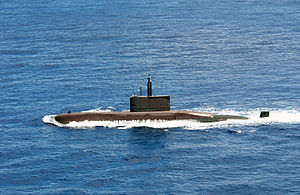 Republic of Korea (ROK) Jang Bogo Type 209/1200 Submarine Jang Bogo heads out to sea during exercise Rim of the Pacific (RIMPAC) 2004.
| |
| Class overview | |
|---|---|
| Name | Jang Bogo class |
| Builders | |
| Operators | |
| Succeeded by | Type 214 submarine |
| Subclasses | Nagapasa class |
| Cost | |
| In commission | 1993–present |
| Planned | 15 |
| Completed | 12 |
| Active | 11 |
| Laid up | 1 |
| General characteristics | |
| Displacement | 1200–1400 tons |
| Length |
|
| Beam | 6.3 m (21 ft) |
| Draft | 5.5 m (18 ft) |
| Propulsion |
|
| Speed |
|
| Range |
|
| Endurance | 50 days |
| Test depth | 500 m (1,600 ft) |
| Complement | 33 |
| Armament |
|
The Jang Bogo-class submarine (Hangul: 장보고급 잠수함, Hanja: 張保皐級潛水艦) or KSS-I (Korean Submarine-I) is a variant of the Type 209 diesel-electric attack submarine initially developed by Howaldtswerke-Deutsche Werft (HDW) of Germany, intended for service with the South Korean Navy and Indonesian Navy. A Daewoo (DSME)-upgraded model of the Jang Bogo class Type 209 was exported by Korea to Indonesia in 2012, amid heavy competition from Russian, French, and German-Turkish consortiums including from Germany's original Type 209.[3] The variant was considered for possible purchase by Thailand as well, as both newly built and second-hand options.[5] The class is named for ancient Korean maritime figure Jang Bogo.
- ^ Franz-Stefan Gady (2016-03-29). "South Korea Launches First Indonesian Stealth Submarine". The Diplomat. Archived from the original on 2017-05-02.
- ^ a b "Korea wins $1 bil. Indonesian deal". koreatimes. 2011-12-20. Archived from the original on 2023-09-11. Retrieved 2023-09-11.
- ^ Cite error: The named reference
NagapasaBatchIIwas invoked but never defined (see the help page). - ^ "Thailand Nixes Second-Hand U206 Submarine Deal But Stands up a Sub Squadron". Defense Industry Daily. 10 July 2014. Archived from the original on 29 July 2012. Retrieved 11 September 2023.